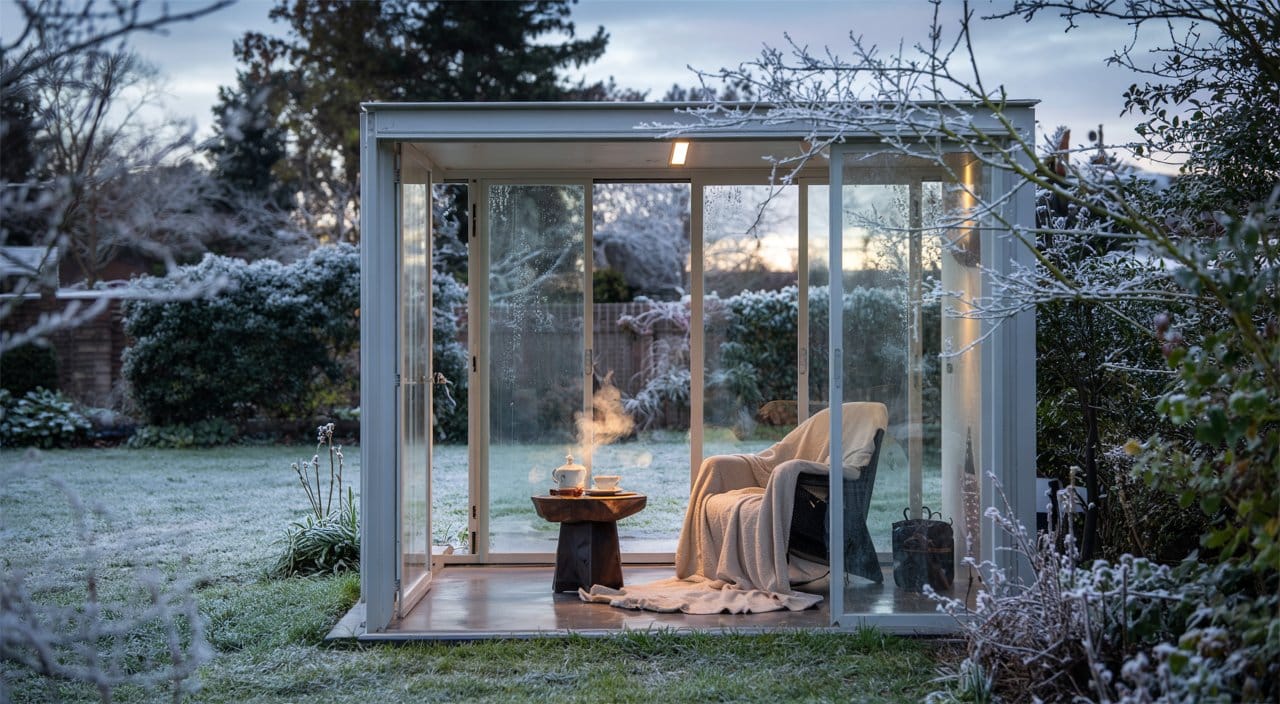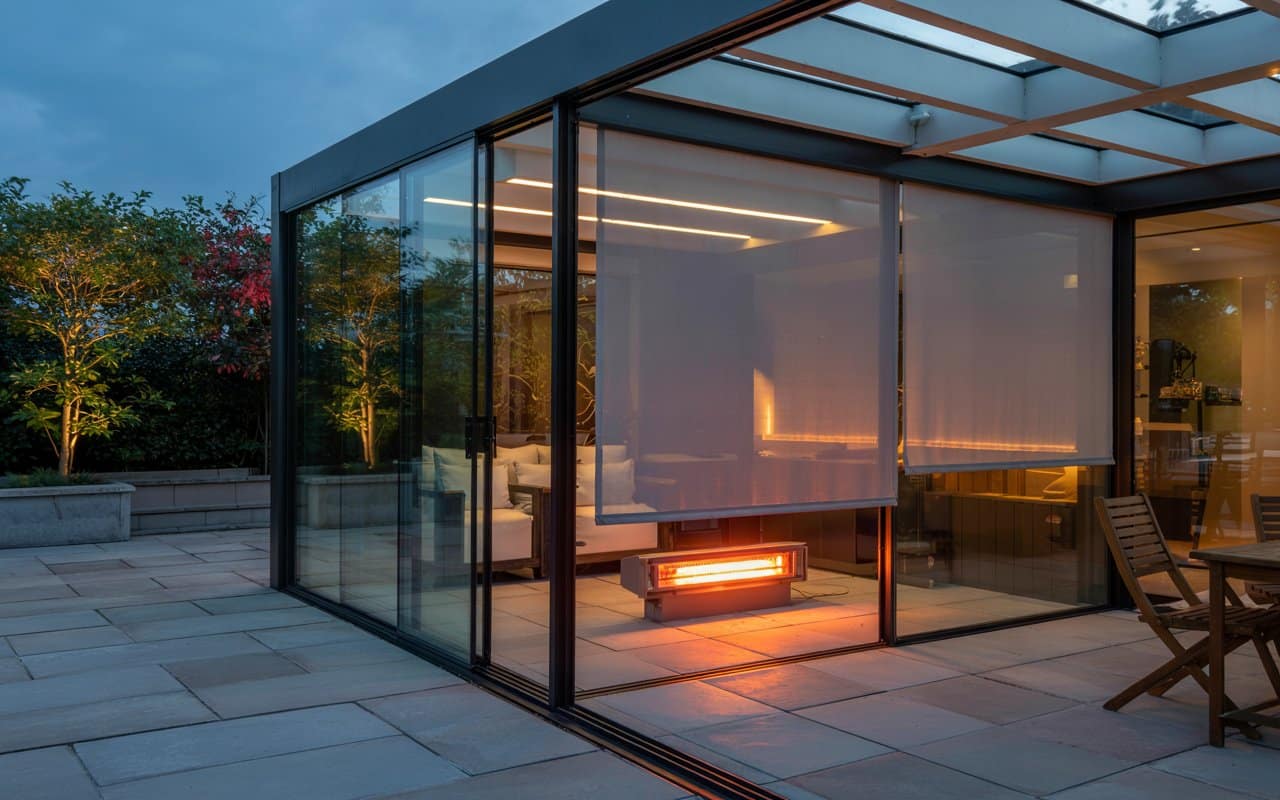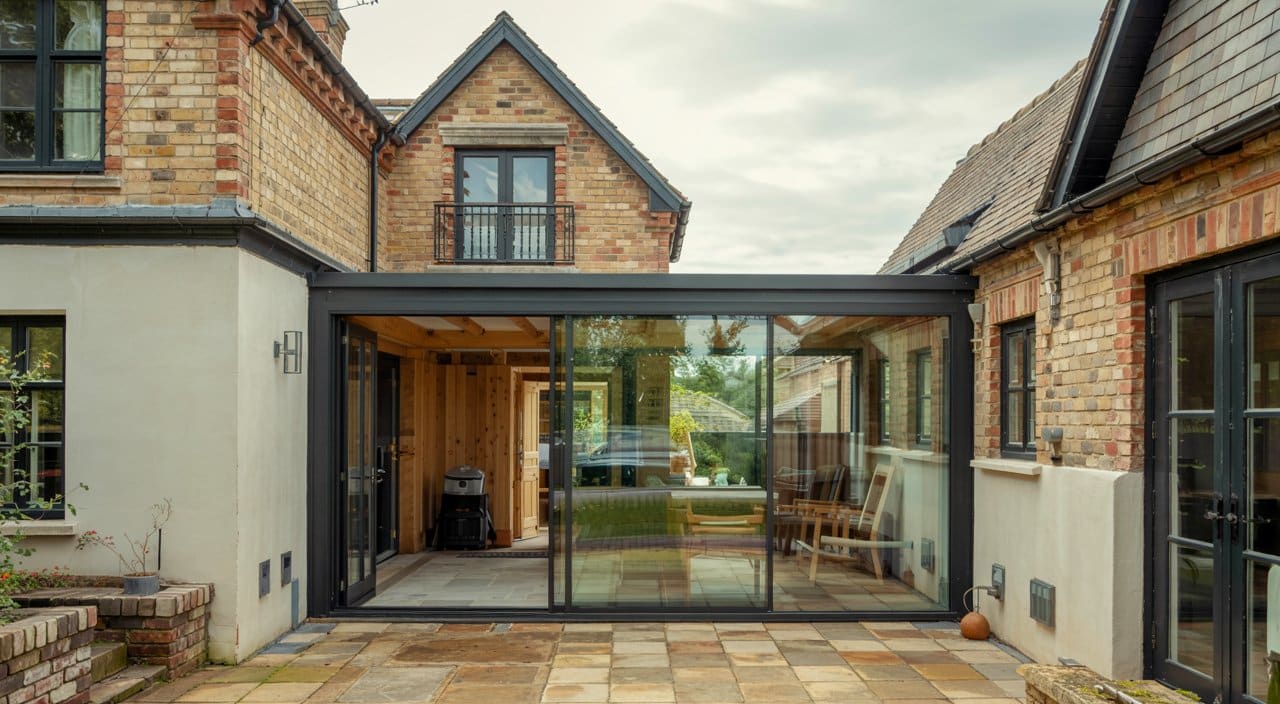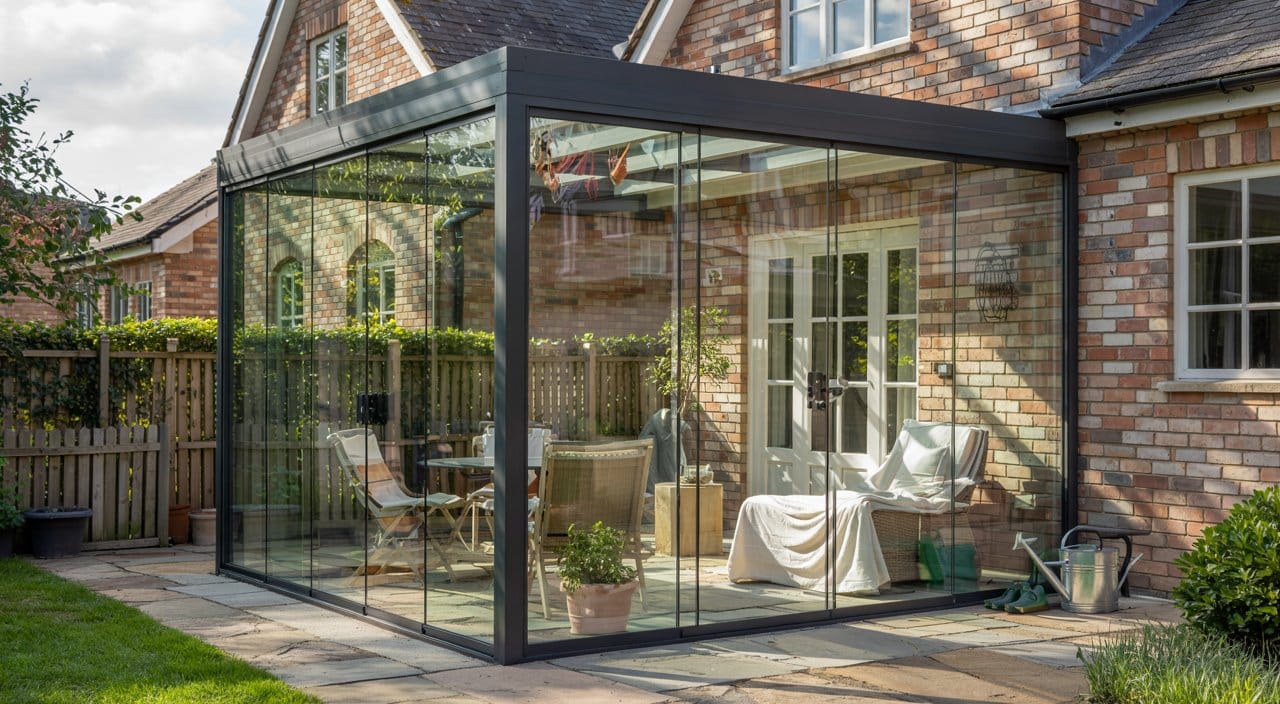Can Modern Glass Rooms Deliver True Winter Comfort?
When daylight shrinks and cold anchors itself in your garden, too many home extensions sit unused, their promise stifled by frosted panes and unwelcome draughts. The real question at the heart of contemporary outdoor living is not whether you can fill a space with light, but whether you can inhabit that light in January—with bare feet, a mug of tea, and absolute assurance that warmth is as present as clarity.
“Watching the rain, wrapped in warmth, brought us closer as a family than any renovation before.”
This possibility was not always available. For decades, seasonal structures like conservatories led homeowners astray, luring them with the hope of all-year living only to deliver months where condensation reigned and utility fell away. The transformation comes from treating comfort as an engineering equation—calculated, verified, and designed with the homeowner’s lifestyle at the fore.
The biggest leap is invisible: insulating glass that admits winter sunlight but bars the exit of heat, frames that refuse to transmit cold, and seals that turn away gale and drizzle. Each choice—triple glazing, frameless joins, precision heating—exists to create harmony between climate and expectation. Yet technical prowess is only half the formula. The other half is emotional: the quiet confidence to invite friends for dinner in February, to start each morning with the garden as a companion, never a forgotten corner.
This is the glass room as it was meant to be—always open, always living, each moment shaped by comfort rather than compromise. For our clients—those who cherish form woven expertly with function—this is not luxury; it is the outcome of structural foresight, expert detailing, and decades of projects obsessed with erasing the boundaries between home and season.
What Technical Breakthroughs Make Winter Glass Rooms Possible?
Comfort in winter relies not only on a promise, but a basis in material science. The path from cold, fog-shrouded garden rooms to today’s serene havens is paved with technical milestones designed specifically to conquer the perennial threats of heat loss, moisture, and brittle, draught-prone structures.
The Science of Insulation
- Triple or double glazing is the foundation, using insulated glass units filled with argon or krypton. These barriers reduce conductive heat escape to negligible levels.
- Low-emissivity coatings bounce radiant warmth back into your space, creating a greenhouse effect in the best sense—daylight streams in, but heat stays put.
Frame and Structure Advancements
- Thermal-break aluminium frames refuse to pass cold from outside in. Multi-chambered profiles, precision seals, and gaskets prevent cold bridges around every opening and connection.
- Pressure-equalised sealing at doors and sliding elements ensures air stays on your side of the threshold—no more whistling gales or creeping damp.
Intelligent Environment Management
- Sophisticated climate sensors monitor and regulate environment adaptively. Humidity never outpaces automated roof vents and wall extractors, keeping glass clear and temperatures stable.
- In-floor and radiant heating is nearly silent, hidden from view but never from impact—responding to the subtlest seasonal swings.
“The technical side disappears until the first storm—then you remember why details matter.”
Reliability comes not merely from slapping tech onto old designs, but from holistically integrating every element from concept through handover. Every Weinor certification is more than paperwork; it is a living warranty that light, warmth, and stability converge in your new favourite room.
Why Are Glass Rooms Superior to Traditional Conservatories in Cold Weather?
Many homeowners recall the icy evenings of their first conservatory with a mix of nostalgia and regret. Traditional builds delivered sunlight—as long as frost wasn’t in the forecast. Winters brought cold radiating off the glass, rivers of condensation, and relentless maintenance. It wasn’t just comfort that failed, but the expectation that the outdoors could ever truly be tamed.
Where Older Builds Faltered
- Single-pane walls and basic metal frames allowed heat loss, drastically increasing energy bills and erasing comfort after sundown.
- Water-laden sills became maintenance nightmares as condensation settled, leading to paint damage, mould, and premature structural fatigue.
- Inflexible installation—more bolt-on than integration—cut thermal continuity between old and new, setting up a constant battle with draughts and moisture.
- Low wind and snow tolerance created risk in storm seasons and disallowed use in truly inclement weather.
Compare That to Our Modern Glassroom Systems
- Argon-insulated glass maintains stable temperature swings, rewarding you with comfort long beyond summer.
- Multi-seal architecture neutralises air movement, while condensation control keeps walls and floors dry, whatever the weather.
- Structural load calculations and BSI compliance assure you of safety as well as usability—even under snow.
- Integrated heating, smart ventilation, and modular shade allow tailoring by climate, use, and orientation.
- Warrantied fit and finish means a future of ease, not repair.
| Feature | Conservatory | Modern Glass Room |
|---|---|---|
| Glass Type | Single | Double/Triple, Low-E |
| Condensation Control | Limited | Automated, Modular |
| Frame | Metal/Wood | Thermal Break Aluminium |
| Heating Support | Passive | Smart/Radiant/Underfloor |
| Durability | 10–15 Years | 30+ Years (Engineered) |
The net result? Homeowners move from disappointment—abandoned rooms, chilly birthdays, closed-off patios—to a steady, predictable living experience. This is not just a build; it is an emotional upgrade for every cold season ahead.
How Do Site Orientation and Installation Expertise Influence Winter Success?
Precision-guided homeowners and architects know that location transforms the possible into the exceptional. Glass does not insulate by itself—no executive product choice can overcome a north-facing exposure left untreated, nor can hope compete with strategic placement. It is not only what you build, but how you map it to your home’s unique landscape that decides year-round comfort.
Key Determinants of Performance
- Orientation: South and southwest exposures capture low winter sun for natural, passive heating. North-facing installations demand higher spec on glazing and thermal breaks.
- Microclimate Influence: Existing garden features, neighbouring plots, and local wind channels inform where heat and moisture gather or dissipate.
- Structural Integration: Joinery that continues the building’s envelope—through shared insulation layers, vapour checks, and contiguous thermal breaks—delivers seamless comfort.
- Installation Artistry: Only installers who measure, test, and adapt their fit to each property eliminate air leaks, cold spots, and microclimate risks. The best glassrooms are as personalised as the architecture itself.
“Watching the way the sun shifted, even in January, shaped the way we designed every corner.”
This process begins long before materials are ordered. Site studies, detailed thermal imaging, and collaborative walkthroughs with our planning teams ensure that every season yields only enjoyment, never surprise. After all, no amount of technology compensates for poor siting—but the right assessment unlocks the best design for your property.
What Are the Essential Features of a Winter-Optimised Glass Room?
Winter relevance is earned through components that place performance above any catalogue claim. Our winter-ready glassroom checklist includes:
- Triple-glazing or high-performance Low-E double glazing calibrated and field-tested
- Thermal-break aluminium frames with multi-chamber insulators and layered seals
- Motorised and programmable shading to manage passive solar gain and reduce daily temp swings
- Adaptive infrared or underfloor heating so every zone feels comfortably even
- Humidity and condensation management: automated vents, microclimate monitors, self-cleaning coatings
- Durable, maintenance-minimising fit and finish suited for decades
| Component | Role in Winter Comfort |
|---|---|
| Triple Glazing | Heat retention, condensation control |
| Thermal Break Frames | Eliminates draughts, cold bridges |
| Automated Shades | Enhances insulation, manages light |
| Smart Heating Integration | Maintains habits, adapts by weather |
| Roof & Wall Ventilation | Clear views, dry interiors |
| Modular Accessories | Custom fit to your lifestyle needs |
“Each upgrade meant one less thing to worry about—no more worries about heating, cold, or wear.”
Every design should be stress-tested on paper and in the field before the first beam goes up, ensuring your investment isn’t only fit for the home—it’s prepared for the full rhythm of the British climate.
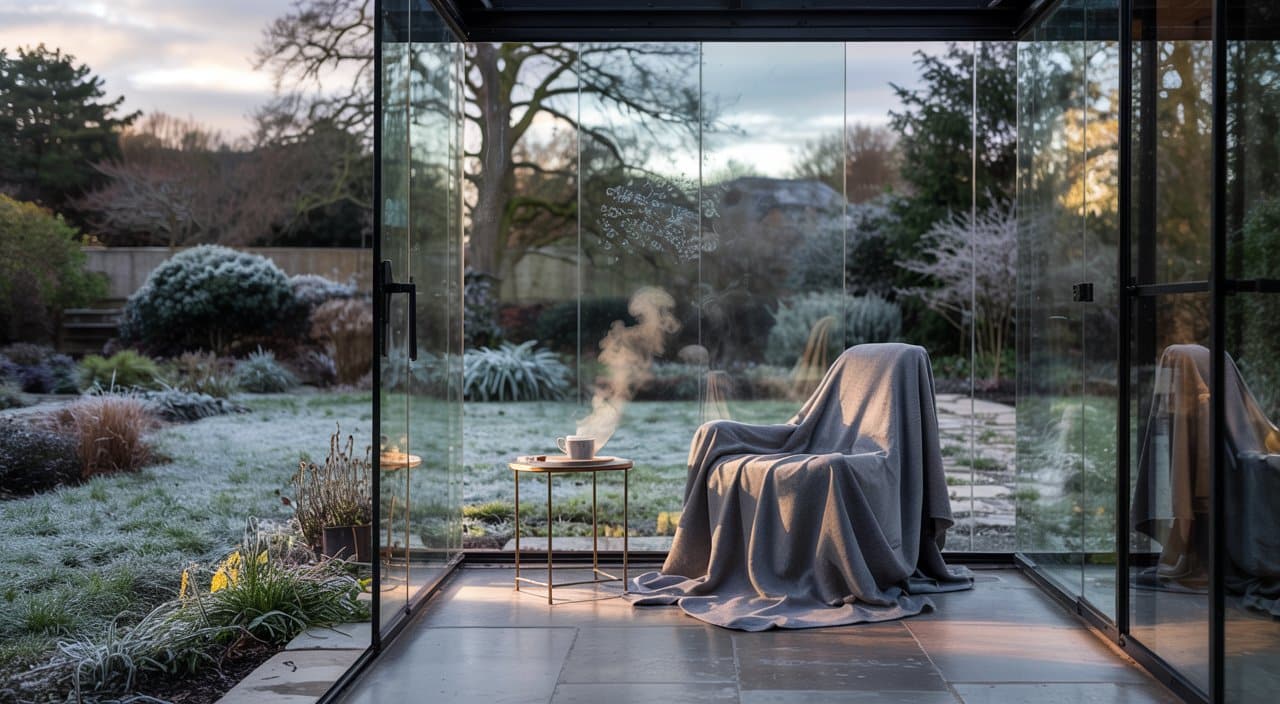
Where Do Energy Efficiency and Sustainability Add Value to Glass Rooms?
Homeowners attuned to sustainability recognise that enduring comfort must not come at the environment’s expense. The most advanced glass room is a testament to what design can achieve when comfort, efficiency, and ecological consciousness converge.
Climate-Positive Choices
- Low-E argon or triple-glazed panels lower energy draw year-round, often exceeding building code mandates.
- Recyclable frame materials reduce the structure’s footprint without sacrificing fit or strength.
- Modular upgrades support solar panel integration, automated rainwater collection, and green roofs.
- Certified environmentally-responsible finishes keep volatile organic compounds and toxins out of your home.
| Sustainability Feature | Long-Term Benefit |
|---|---|
| U-value below 1.0W/m²K | Reduces bills, maintains heat |
| Integrated Solar Readiness | Upgrades to net-zero future |
| Green Material Certification | Protects air, minimises impact |
| Passive Solar Management | Fewer active heating hours |
“Lower bills and a clear conscience—that’s comfort I can live with.”
Choosing the right system is not a matter of spreadsheets or annual reports, but a storey told through every season—years when your living space shrinks its impact but expands in warmth, clarity, and reliability. Ongoing maintenance—and simple upgrades, done right—keep your investment performing to peak standard across decades.
How Should You Evaluate Performance, Reliability, and Compliance?
Confidence in a glass room endures only when it is founded on verifiable standards and clear evidence of reliability. We encourage every homeowner and developer to approach winter comfort as a series of objective questions—each answer serving as a proof point, not a vague assurance.
Your Assurance Checklist
- Demand documented specs for U-values, environmental tests, and frame performance.
- Insist on certification: BSI, GGF, and other authoritative safety and insulation marks.
- Evaluate wind, snow, and thermal load data—your glass room must withstand local forecasts, not just standard predictions.
- Request transparent warranty terms: What is covered, for how long, and under what usage?
- Review installer history: Look for completed winter-ready projects and independent testimonials.
- Ask for real-world scenario results: Has the room survived previous unusually cold or wet seasons? What was the aftercare experience?
| Performance Metric | What Good Looks Like |
|---|---|
| U-Value (Glazing/Frame) | ≤ 1.0 W/m²K |
| BSI/UK GGF Compliance | Full Certification |
| Snow/Wind Resistance | Tested, project-specific data |
| Warranty | Full weather performance term |
| Installer Reputation | High volume, low callback |
“We compared specs, asked for numbers. It’s the way we approach every big decision—and it paid off.”
This diligence transforms projects into investments that return value with every passing season, reducing both energy burden and future risk.
For a Free Design Consultation, Contact The Outdoor Living Group Today
Increasing comfort, seamless outdoor-connected living, and responsible sustainability—these are within your reach, not just a “maybe” for someday. Our approach at The Outdoor Living Group champions the idea that every glass structure should harmonise with its environment, suit your daily ritual, and endure every test of climate or use.
“It’s the upgrade we didn’t expect to use so much through winter—but now, it’s the room we use most.”
We welcome you to begin the journey to winter-ready living with a personalised, no-pressure design review. Whether your home beckons for all-season clarity or your business seeks to reclaim outdoor capacity every month of the year, the difference is found in collaboration, evidence, and expertise. Every project we undertake is informed by a lifetime warranty in trust—and measured by the warmth you feel, however you define it.
Frequently Asked Questions
What Are the Essential Features of a Winter-Optimised Glass Room?
Winter demands more than architectural confidence—it calls for seamless performance that anticipates the worst while delivering the best. The transformation from “three-season sunroom” to a glass sanctuary that defies chill hinges on a careful orchestration of material, detail, and silent system synergy. Our approach at The Outdoor Living Group begins not with spectacle, but with the precise layering of every component for function and harmony in even the most inhospitable months.
“The cold never finds us; every night in our glassroom is as inviting as the warmest morning.”
Insulated Performance: Building from the Core
The art of winter optimization starts with multi-layered glazing—triple-pane or high-performance double-glazed glass, filled with argon or krypton, and surfaced with low-emissivity films. This barrier acts both as a shield from the external cold and as an energy amplifier, capturing passive sunlight while resisting heat loss. Surrounding this core, our thermally broken aluminium frames wield composite or multi-chamber technology: each threshold, pivot, and frame intersection is a deliberate block to conductive cold.
Climate Control Meets Invisible Technology
True comfort isn’t dictated by weather; it’s engineered through adaptability:
- Radiant floor or panel heating overlays gentle warmth at ground and seating level. Unlike traditional forced air, our systems deliver consistent, draught-free conditions—never a cold footfall or sudden chill.
- Programmable blinds and climate-integrated shades offset waning sun or clear night heat loss, responding automatically or on your schedule to maintain visual privacy and thermal equilibrium.
- Ventilated control layers, from trickle vents to humidity-responsive roof windows, gently usher in fresh air without inviting outside cold or condensation. Every pane stays clear; every view, inviting.
Day-to-Day Durability and Ease
A winter-ready glass room thrives in exposure:
- Powder-coated frames resist corrosion and remain flawless through years of windblown rain and snow.
- Self-cleaning glass coatings cut down on streaking and frost, Giving you more time to enjoy the space and less time maintaining it.
- Custom layouts—corner structures, modular walls, or phased additions—adapt to your evolving property and rhythm.
| Component | Purpose in Winter Comfort |
|---|---|
| Triple Glazing/Low-E Glass | Heat retention, condensation block |
| Thermal Frame/Insulation | Full perimeter defence, draught stop |
| Adaptive Heating | Zonal control, even warmth |
| Automated Shading | Insulation, glare, privacy control |
| Active Ventilation | Moisture management, air clarity |
| Smart Integration | Personalization, effortless routine |
| Durable Weather Finish | Longevity, minimal upkeep |
Where lesser projects offer checklists, our company blends each layer into a singular experience of stillness, peace, and zero surprises—no cold snaps, no nightly adjustments, just the assurance of real all-winter living.
Where Do Energy Efficiency and Sustainability Add Value to Glass Rooms?
True sustainability is measured both by the energy your home saves and the daily security you feel knowing your choices echo beyond the present. Our glassrooms fuse environmental intent with comfort, stripping away the legacy notion that eco-conscious means sacrifice. Here, green is an added benefit, never a compromise.
“It surprised me how much less we spend to keep the glassroom warm, and how much better I sleep knowing we’re not burning more than needed.”
Efficient by Design, Responsible by Material
- Low-U value, argon-filled glass—ensuring retention of warmth, sharp reduction in energy bills, and significant insulation even when snow builds outside.
- Naturally recyclable aluminium frames with non-toxic, weatherproofed finishes stand up to decades of British weather without repainting or solvent-heavy maintenance.
- Passive solar gain optimization—south and southwest layouts maximise sunny winter hours, so bright mornings mean automatic comfort.
Living Low-Impact, Without Limitation
- Future-ready structures: Our designs allow for seamless integration of solar panels, green roofs, or rainwater capture; accessories slot in when your needs expand.
- Automated resource use—rainwater directed for garden irrigation, heating and lights triggered not by guesswork, but by occupancy and ambient light or temperature.
The Tangible Payoff: Numbers and Narratives
- Homes with optimised glassrooms routinely register 30-50% lower heating consumption for the same lived area compared to older builds.
- Green Home certifications (LEED, BREEAM, or similar) now factor glassroom performance into home rating systems; value compounds at sale.
| Eco Feature | Real-World Value |
|---|---|
| U-value ≤ 1.0 W/m²K | Less energy out, lower bills |
| Recycled/Non-Toxic Frames | Healthier, longer-lasting system |
| Solar/Rainwater Integration | Expandable efficiency |
| Passive Solar Orientation | Natural daytime warming |
Every choice you make—whether for the earth, your family, or your future buyers—is reinforced by the resilience and frugality of design married to performance. Our glassrooms prove that sustainability can be as beautiful as it is practical, with every iteration guided by relentless focus on whole-home synergy.
How Should You Evaluate Performance, Reliability, and Compliance?
An investment in a winter glassroom begs only one question: Will it last? Longevity, security, and risk reduction aren’t simply the result of strong features—they’re earned by demanding verification, not vibes.
“Their technical team walked us through every spec. There were no hand-waves, just the calm of certainty.”
The Non-Negotiables
- Full technical documentation: Require actual data for U-values, condensation resistance, and structural loads—never settle for “about” or “should be.”
- Accreditation to GGF, BSI, or CE standards: These aren’t badges for an about-us page, but legal and material lifelines in the coldest season or the strongest storm.
- Installation milestone records: Each stage (foundation, frame, fit, finish) must pass checklist-backed verification, not simply installer satisfaction.
Troubleshooting Supports, Not Surprises
Know before you build, and don’t cross your fingers after:
- Inspect for draughts at seams and vents; anything more than a gentle chill is risk, not comfort.
- Check drainage, seals, and condensation on cold mornings; expect the same clarity in the New Year as on move-in day.
- Probe aftercare coverage: Who you call isn’t as important as how they answer—look for prompt, lifetime support agreements and a track record of proactive, solution-first service.
Scenario-Based Checks
When comparing bids, put every offering through these trials:
- Has the product line faced a winter like your own—proven, not promised, across client geographies?
- What recourse do you have if condensation, leaks, or unclear responsibility emerge two, five, or ten years in?
- Do they fundamentally understand the local requirements (snow loadings, insurance, wind certification), or are they repackaging continental specs?
| Assurance Step | Importance |
|---|---|
| Certified Data | Non-negotiable buying decision |
| Standards Compliance | Insurance, resale, and legal security |
| Audit Reports/Inspections | Real progress, not promises |
| Aftercare/Warranty | Peace, not phone tag |
Every client who chooses The Outdoor Living Group gets a binder of data, not just a photo gallery—testimony in spec, checklist, and storey. When you treat diligence as a celebration, rather than a hurdle, every season’s comfort feels doubly reliable.
For a Free Design Consultation, Contact The Outdoor Living Group Today
The first step is quiet: a walk around your property, an assessment of light and habit, a conversation about tomorrow. The real journey is not from idea to installation, but from hesitancy to absolute confidence—measured day by day, as each winter proves how right your decision was.
“Winter is no longer something we hide from. The garden feels bigger, every evening longer.”
When you invite our team to guide your design, you claim more than air-tight glass or weather guarantee; you claim the possibility of year-round belonging. We tailor our proposals to moments you actually live: morning tea in January, reading by the last light, children’s laughter even as rain streaks the sky.
We do not cold-call or rush; each plan emerges from observed detail—paths of shadow, gust and calm, the wishes you kept to yourself until now. The conversation moves from what can be built to how your house and garden can dance. As the process unfolds, you notice a shift: less “what if,” more “what next?” That assurance—rooted in our engineering, aftercare, and culture of doing things right the first time—stays with you, in every storm and every thaw.
If you’re ready to let habit and horizon expand, our company will answer. The comfort of a truly four-season life is closer than it’s ever been.
What Factors Determine If a Glass Room Is Truly Comfortable in Winter?
The Subtle Science of Year-Round Warmth
Too many homes feature glassrooms that fall silent the moment frost creeps across the panes. A winter-ready glassroom is not an architectural privilege—it is the measured result of orientation, insulation, dynamic technology, and daily rituals engineered seamlessly into your space. The first decision is never about size or style, but direction. South-facing installations bask in soft winter sunlight, building up passive warmth long after noon. Even east and west orientations afford reliable comfort, provided they are shielded from prevailing winds and designed with microclimates in mind.
“It’s not just the glass—it’s the way the whole room seems to trap the sun and send the cold somewhere else.”
Insulation and Structural Precision
High-quality insulation acts as the room’s silent steward, retaining the heat inside and deflecting any external chill. Our multi-chambered, thermally broken frames, filled with proprietary insulation blends, defeat cold bridges and block air leaks at every seam. Without these, no thickness of glass can consistently preserve internal comfort.
Dynamic Adaptation
Advanced blind systems and micro-ventilation are the choreography—responding to dusk, humidity, and unexpected cold snaps with invisible intelligence. A glassroom fitted with adaptive shades holds onto the last rays and traps residual heat, while discreet vents relieve excess moisture before dew forms on the glass.
The Value of Routine
Even the best design blossoms under mindful daily use. Opening shades at first light, closing them at dusk, activating supplementary heating during a deep freeze—these small acts convert engineered intent into real comfort. Owners who integrate these behaviours report richer, more reliable enjoyment throughout the winter.
Expert Planning for Unique Properties
No two gardens are alike, and microclimates can change from one end of your plot to the other. A professional design-and-assessment process examines slope, shading patterns, and even your paving stone colour to recommend the best passive and active strategies for warmth. Unlike generic templates, our consultations ensure each glassroom speaks to your property’s unique patterns—so every winter day is lived, not lost.
Why Is Winter Condensation Rare in Modern Glass Rooms?
Defeating the Dreaded Fog
Condensation once defined the glassroom myth: even a little humidity could turn views hazy and interiors moist. Yet with advances in both the physical barriers and ‘living’ technologies of our glassrooms, those foggy winter mornings are now reserved for the world outside, never within your space.
Multi-Layered Barriers
The secret begins with layers of insulated glass. Each pane contains “warm edge” spacer bars made from non-conductive materials, breaking the thermal transfer that usually causes cold glass and condensation. Filled with argon, our double- and triple-glazed panels slow down the passage of interior moisture to the dew point interface.
Smart Ventilation and Humidity Management
Today’s best glassrooms gently breathe. Unseen roof trickle vents, micro-fans, and humidity sensors pulse into action when steam or breath threatens clarity. These features rid your space of excess moisture long before it condenses on a surface, maintaining a constant, dry interior climate—even through marathon family dinners or winter baking bursts.
Invisible Shield: Maintenance-Free Coatings
Every glass surface in our premium installations comes shielded with a hydrophobic, self-cleaning coating. Water beads and runs off, dirt doesn’t adhere, and even in wet weather your view remains crystal-clear. No daily squeegee, no paranoia.
Embedded Owner Guidance
We guide each client in calibrating their airflow for each season. Routine—like a quick airing after cooking or adjusting blinds to encourage thermal balance—prevents problems before they occur. Our maintenance plans reinforce this barrier with seasonal checks, optimising ventilation and seal performance year after year.
The Aftercare Difference
A glassroom’s defence against condensation is only as good as the team standing behind it. Regular aftercare, proactive servicing, and clear visual checks mean clarity isn’t just possible—it’s predictable, year after year.
How Can You Assess the Energy Efficiency of a Glass Room Before Installation?
Decoding Efficiency: The Science Behind the Warmth
Energy efficiency isn’t a vague promise; it’s a checklist backed by science, ratings, and comparables drawn from the best of European standards. The key question for owners is not just which specification looks appealing, but which combination of data points consistently defeat British winter cold without punishing your bills.
Understanding the Numbers
- U-value: The gold standard in glazing. For true all-season comfort, target a U-value under 1.0 W/m²K. Anything higher welcomes heat loss; anything lower secures interior warmth.
- R-value: The resistance value of insulation in bases or roofing—beyond the glass. Higher means longer intervals between heating cycles and more balanced comfort.
- Triple/Double Glazing: Each extra layer means exponential, not linear, improvement.
Trusted Certification
Efficiency is validated through universe-recognised certifications such as BSI kitemarks and endorsements from the Glass & Glazing Federation. These bodies demand real-world, weather-based testing—never just lab results.
Side-by-Side Model Analysis
Ask us to stack your preferred model’s performance against leading alternatives in a markdown-style table:
| Spec | Weinor Triple Glaze | Standard Roof | Legacy Conservatory |
|---|---|---|---|
| U-value (lower=better) | 0.9 | 1.5 | 2.2 |
| GGF Certified | Yes | Varies | Seldom |
| Solar Gain Modelling | Offered | Rare | Not Supported |
| Smart Shading | As standard | By request | Absent |
Calculator-Driven Clarity
While tools and calculators are never a substitute for a proper site assessment, checking seasonal averages for heating and cooling with your exact room simulation brings peace of mind. Questions about expected kWh consumption, cost savings, and performance in low-light months? Your answers should come from validated predictive models, not estimate ranges.
Simulation Adds Certainty
Working with site-specific simulations—informed by your home’s sun path, wind exposure, and usability goals—means design choices are led by your comfort, not just catalogue stats.
When Should You Consider Upgrading an Existing Glass Room for Better Winter Use?
The Season for Upgrades: Listening to What Your Glassroom Tells You
A well-designed glassroom adapts to seasons and needs, but age, outdated glazing, or previous “value engineering” may call for a strategic refresh. How do you know when that line is crossed—and how do you act with confidence?
Warning Signs Requiring Action
- Persistent cold, even with supplemental heating
- Visible condensation, damp sills, and frame discoloration
- New, recurring draughts, especially after wind or rain storms
- Noticeably higher energy use over each winter month
If these issues are consistent, retrofit or upgrade will not simply raise day-to-day comfort—it will restore your space as an all-year asset, not a weather-limited feature.
Targeted Paths to Improvement
Consider phased or holistic upgrades:
- Replace single or unusable glazing with double/triple, warm-edge, argon-filled units
- Add improved insulation at floor or threshold
- Instal responsive, programmable heating (infrared, underfloor, or hybrid panels) tailored to your room size and layout
- Replace or augment old gaskets and seals
- Incorporate smart shading or micro-ventilation for moisture control
Timing and Project Management
Late summer to early autumn guarantees upgrades complete without urgent disruption. Installers can fine-tune new components, test with cooler weather, and hand over for the season’s first true frost.
Value of a Professional Review
Even advanced owners may miss subtle heat bridges or hidden ventilation issues. Engaging with our specification review and on-site audit often identifies unseen performance gaps. Small fixes sometimes cure big symptoms.
Why Not Every Room Needs a Full Overhaul
For many, incremental, affordable adjustments deliver the greatest comfort-to-cost ratio. Only a full professional review can tell—saving you from guesswork and repeated expense. If your glassroom is asking for help, a strategic upgrade gives it a new lease on the winter calendar.
Why Are Glass Rooms Superior to Traditional Conservatories in Cold Weather?
The Evolution from Seasonal Regret to Perennial Retreat
Conservatories founded an industry on summer promise and winter heartbreak. Their design—single glazing, poorly insulated frames, and minimal moisture management—often bred disappointment, not delight. Our modern glassrooms represent a leap forward on every comfort metric that matters.
Where Yesterday’s Designs Stumbled
- Single-pane glass: Invites cold and leaks internal warmth.
- Aluminium or wood frames, uninsulated: Create persistent cold spots and frames prone to rot or rust.
- Poor condensation control: Requires daily intervention; fosters mould and maintenance cycles.
- No smart adaptation: Only brute-force heating; inefficient and patchy.
The Modern Glassroom’s Triumph
- Multi-layered, inert gas-filled glass: Retains heat while resisting outside chill.
- Thermal break aluminium frames: Prevent internal-external temperature bridging.
- Seamless moisture management: From passive venting to self-cleaning glass, the system ‘works’ for the owner, not vice versa.
- Integrated tech: Programmable heating, adaptive shading, humidity control. Less effort, more reward.
| Key Feature | Legacy Conservatory | Modern Glass Room |
|---|---|---|
| Glazing | Single Pane | Double/Triple |
| Frame Type | Basic Metal/Wood | Thermal-Aluminium |
| Moisture Handling | Manual Only | Smart Tech + Vents |
| Heating Effectiveness | Uneven/Costly | Smart/Consistent |
| Maintenance Cycle | Intensive | Occasional |
Lifestyle Outcome
Owners move from avoidance—shut doors, postponed meals, holiday disuse—to anticipation. Glassrooms don’t simply last longer; they make winter one of the best times to savour the garden. The difference is structural genius, not mere material.
What Technical Breakthroughs Make Winter Glass Rooms Possible?
The Hidden Logic of Perpetual Comfort
To call a glassroom “warm” is to credit decades of precise innovation. The change has been incremental yet relentless—each new element introduced to solve one flaw at a time.
Insulating Glass Evolution
Three-pane, low-E, argon-filled glass units offer tenfold the thermal performance of their grandparents. Their warm-edge spacers, UV coatings, and gas fills are less a luxury, more a requirement for credible winter living.
Framing and Bridge Defences
Thermal breaks matter: each chambered frame, modern gasket, and non-conductive pivot is the line between a gentle room and a chilly one. Our Weinor-certified installations guarantee that every edge has been battle-tested against cold ingress.
Adaptive Comfort Systems
Where manual heating once stood dominant, silent radiant panels, infrared units, and smart thermostats usher in a new standard for consistent warmth. The real transformation, however, is invisible: sensors, passive solar modelling, and automated shading coordinate across your glassroom’s microclimate, not just the weather outside.
| Breakthrough | Benefit |
|---|---|
| Triple-layer Glazing | Superior insulation, clarity |
| Thermal Frame Technology | No cold spots or condensation |
| Smart Shading | Manages passive gain, glare |
| Responsive Heating | Even, targeted comfort |
| Integrated Ventilation | Keeps views clear, air fresh |
Integrated System Design
Gone is “bolt-on” thinking. Success now requires that every element—from underfloor insulation to micro-vents—is engineered with the system in mind, not as an afterthought. When form and technology partner, the room becomes what the architect promised—the extension of your living, no matter the month.
How Do Site Orientation and Installation Expertise Influence Winter Success?
Mapping Comfort onto the Sun Calendar
You can’t outsmart orientation, but you can embrace and enhance it strategically. Comfort happens in glassrooms when sunlight, windbreaks, and architectural integrity align.
Siting and Passive Heat
Smart siting maximises the arc of the winter sun—southern exposures do this effortlessly, while corners shaded by trees or structures are carefully compensated with enhanced insulation and smart venting. Our approach is both art and science: we evaluate every angle, navigation, and prevailing wind before a foundation is poured.
Microclimate Awareness
No two plots are equal. Quadrant differences in wind speed, moisture, and shade mean even neighbouring properties may require dramatically different specifications. Owners who partner with our team gain insights into these details and the ability to plan proactive, rather than reactive comfort interventions.
Tailoring Structure to Architecture
Not every home’s envelope can be extended identically. Our design strategy integrates critical details—matching ground insulation, overhangs, vapour barriers, and colour coordination. Precision installation solves for cold spots, irregular draughts, and condensation far more efficiently than “fit and hope” strategies.
The Installer’s Signature
Our experience is that the difference between space you enjoy every day and space you abandon by February is defined by installer decision over catalogue options. The right expertise in fit, seal, vent placement, and solar mapping changes outcomes—sometimes forever.
“Sun angle mattered in ways we never imagined, until it brought more light into winter than we thought possible.”
Where Do Energy Efficiency and Sustainability Add Value to Glass Rooms?
Comfort without Compromise
Sustainability has a practical benefit: it cuts bills and secures comfort without demanding sacrifice. Our glassrooms raise expectations—delivering both daily pleasure and a responsible long-term footprint.
Lower Bills, Lighter Conscience
Key sustainable choices are the rule here, not the exception: – Low-U, high R-value glass units – Recycled and toxin-free framing – Solar and rainwater ready infrastructure – Efficient, zone-worthy heating/cooling with smart sensors
| Sustainability Factor | Net Result |
|---|---|
| 1.0 W/m²K U-value glazing | Lower energy bills, higher comfort |
| Green-certified frames | Long-lived, no health risk |
| Solar/rain adaptability | Value return over lifetime |
| Automated controls | Resource use tightly aligned to need |
The Test: Real-World Usage
Homeowners in optimised glassrooms routinely cite 30%+ reductions in heating bills versus older builds or poorly designed prototypical rooms. Those who plan with future integration—solar, sensors, green roofing—find that “future-ready” is as valuable as “warm tonight.”
Aesthetic Integration
Our focus on sustainability is never at the expense of design. Material choices, layout planning, and hidden resource capture all dovetail into the visual rhythm of your home and garden, never disrupting what drew you to the idea in the first place.
How Should You Evaluate Performance, Reliability, and Compliance?
Making Trust Tangible
To secure winter performance, rely on data, not just description. We’ve learned that audit trails ensure comfort lasts far beyond the first cold front.
Before Build: What to Demand
- U-value, R-value, and moisture data for every component
- Accredited certification (CE, BSI, GGF, UK building codes)
- Scenario testing—show specific weather outcomes, not just averages
At Installation: Real-Time Verification
Every project passes through a clear checklist:
- Pre-fit moisture and draught testing
- Verification of all insulation, venting, and shading unit integration
- Signed-off checklist confirming every spec before moving to next stage
Aftercare: The True Foundation of Reliability
- Routine checks and immediate intervention for any deviation (draught, moisture, or thermal inconsistency)
- Clear warranty process, covering weather exposure and use
- Documented instal history and a single point of contact for future query resolution
- List of prior installations in your climate, providing peace-of-mind beyond any “guarantee” clause
| Verification Step | What Owners Receive |
|---|---|
| Pre-fit Checklist | Confirm spec reality |
| Certified Fitment | Mitigates long-run risk |
| Aftercare Programme | Persistent peace-of-mind |
| Performance Dossier | Benchmark for future upgrades |
“Feedback from past winters—knowing others thrived—became part of our decision, not just the stats.”
For a Free Design Consultation, Contact The Outdoor Living Group Today
Your journey to winter comfort can start quietly—a conversation, a site walk, a design map built from your ambitions, not a preset template. We listen for the life you want to live, not just the structure you hope to fill. Our focus is time-tested: serving as design advocates, not just product providers; personalising every plan with calm confidence.
“The best outcome wasn’t the glassroom—it was the winter where every day felt like a weekend.”
With our team, expect transparency, skill, and unfaltering partnership. We’re ready, whether you want a subtle, streamlined edit for your existing space or a full new build. If you seek a home that draws you outside even when others rush in, we’re here to guide each step.


